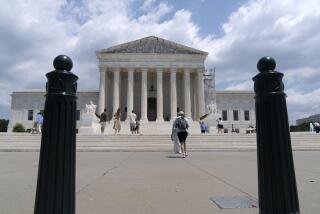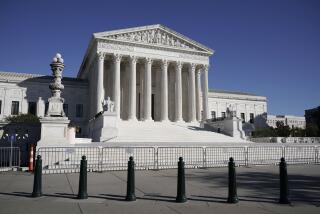High Court Hears Case on U.S. Arts Grants
WASHINGTON — Hearing arguments in a case that blends art, politics and the law, the Supreme Court justices strongly signaled Tuesday that they will uphold a “decency” standard for federal arts grants.
In questions and comments, none of the nine justices suggested that Congress violated the 1st Amendment when it told the National Endowment for the Arts to consider “general standards of decency and respect for the diverse beliefs and values of the American people” when awarding grants.
Indeed, Chief Justice William H. Rehnquist wanted to know why the government did not object immediately when a federal judge in Los Angeles struck down this law six years ago.
“Why didn’t the government seek a stay in this court?” Rehnquist asked, bluntly revealing that he thought the first ruling was in error.
Justices Ruth Bader Ginsburg and Anthony M. Kennedy questioned why four so-called “performance artists” were given standing in court to challenge the law, since they had not lost grants because of it.
“This seems remote and abstract--not a concrete case,” Kennedy said.
And Justice Antonin Scalia, probably the court’s most conservative member, railed at the notion that taxpayers’ money was used to subsidize homoerotic photographs by Robert Mapplethorpe and Andres Serrano’s depiction of a cross dipped in urine.
“I thought the government doesn’t have to buy Mapplethorpe, and it doesn’t have to fund Mapplethorpe,” Scalia said.
The controversy surrounding the NEA heightened in 1989 with the news that federal funds had helped pay for exhibits of work by Mapplethorpe and Serrano.
Congressional critics assailed the arts endowment and threatened to pass laws that would prohibit support for obscene or sacrilegious art. As a compromise, it enacted the warning to consider decency.
In 1990, when the bill was pending, the NEA’s chairman canceled solo performance awards to Los Angeles artists Tim Miller and John Fleck and New Yorkers Karen Finley and Holly Hughes. Three of the four used gay themes in their work. Finley is perhaps best known for appearing on stage covered in melted chocolate.
The endowment later settled the claim, but when the bill became law, the artists challenged it as a free-speech violation. They argued that the decency rule imposed a kind of censorship.
U.S. District Judge A. Wallace Tashima agreed and invalidated the rule in 1992. “The right of artists to challenge conventional wisdom and values is a cornerstone of artistic and academic freedom,” he said. The U.S. 9th Circuit Court of Appeals in San Francisco affirmed that ruling two years ago.
The Clinton administration appealed, leading to Tuesday’s argument in the case (NEA vs. Finley, 97-371).
“We don’t think there is any constitutional problem here,” U.S. Solicitor General Seth Waxman told the justices. No one on the bench objected.
Georgetown University law professor David D. Cole, representing the “NEA 4,” said the endowment is intended to support private artists, not fund government propaganda. The decency rule “singles out art which has a nonconforming or disrespectful viewpoint. Government can’t impose an ideological screen” without abridging the 1st Amendment, he said.
Disagreeing, Justice John Paul Stevens noted that the government funds campaigns to tout the message “Just Say No to Drugs,” through private billboards artists, advertisers and others. “They are financed only to say ‘No to drugs,’ not ‘Yes to drugs,’ ” he said. That ideological restriction does not violate the 1st Amendment, he said.
Cole said the arts endowment is different. It is an open-ended fund to support works of artistic merit, not to promote a message.
But Justice Stephen G. Breyer wondered if the NEA is obliged to support art by white supremacists. Without responding directly, Cole said he believes the 1st Amendment does not allow the government to “exclude a work because it has a disfavored viewpoint.”
More to Read
The biggest entertainment stories
Get our big stories about Hollywood, film, television, music, arts, culture and more right in your inbox as soon as they publish.
You may occasionally receive promotional content from the Los Angeles Times.











